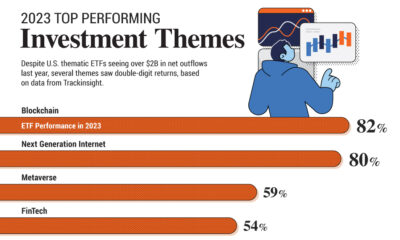Cryptocurrency
The Power of Smart Contracts on the Blockchain

The world is waking up to the impressive capabilities of the blockchain.
As a foundational technology that things can be “built on top” of, the potential applications of the blockchain go way beyond just payments or cryptocurrencies. In fact, the blockchain could revolutionize how we interact with intellectual property, capital markets, insurance, healthcare, government, and many other sectors.
Introducing Smart Contracts
In particular, an exciting enabler of blockchain technology is the concept of self-executing “smart contracts”.
Today’s infographic comes from Etherparty, a smart contract creation tool, and it helps provide a welcoming introduction to how smart contracts work on the blockchain.
Smart contracts are going to change everything from the legal industry to the backbone of the stock market.
Here’s how these self-executing contracts actually work.
The Anatomy of a Smart Contract
Smart contracts help you exchange money, property, shares, or anything of value in a transparent, conflict-free way while avoiding the services of a middleman. Built upon the blockchain, a smart contract is usually:
- Pre-written logic in the form of computer code
- Stored and replicated on the blockchain
- Executed and run by the network of computers running the blockchain
- Can result in updates to accounts on the ledger (i.e. payment for an executed contract)
Using the Ethereum platform, smart contracts can be programmed using basic logic. On the most basic level, they can:
- Perform calculations (i.e. calculating interest)
- Store information (i.e. membership records)
- Send transactions to other accounts (i.e. payment for a good or service)
But most importantly, it is important to know that smart contracts are autonomous. They are not controlled by anyone – instead, they self-execute based on a set of instructions that two parties have agreed to (ie. the code).
Benefits of Smart Contracts
Smart contracts are appealing for a variety of reasons:
- Autonomy: There is no need to rely on third parties, which could be biased or not have your interests at heart.
- Trust: Your documents are encrypted on a shared ledger, and all parties can have access to them.
- Redundancy: Documents are duplicated many times over on the blockchain, and can’t ever be “lost”.
- Safety: Documents are encrypted, making them near-impenetrable by hackers.
- Speed: These contracts automatically self-execute, saving you precious time.
- Savings: Smart contracts save you money by taking out the middleman.
- Precision: Smart contracts execute the exact code provided, ensuring zero errors.
- Transparency: For organizations like governments, they could add another level of transparency to dealings.
The blockchain is already a disruptive technology, and with these benefits – the potential behind smart contracts is another facet to be excited about.
Technology
Ranked: The Largest Bitcoin ETFs in the U.S.
In this graphic, we rank the top eight Bitcoin ETFs in the U.S. by their total assets under management (AUM).

Ranking the Largest Bitcoin ETFs in the U.S.
This was originally posted on our Voronoi app. Download the app for free on iOS or Android and discover incredible data-driven charts from a variety of trusted sources.
In early January 2024, the U.S. Securities and Exchange Commission (U.S. SEC) gave its approval on exchange-traded funds (ETFs) to track Bitcoin, giving investors an alternative pathway to accessing the world’s biggest cryptocurrency.
In this graphic, we’ve shown the eight largest Bitcoin ETFs in the U.S. by assets under management (AUM), as of Feb. 27, 2024. To elaborate, these are ETFs that buy and hold actual Bitcoin, meaning their performance will generally follow that of Bitcoin itself.
The data used to create this graphic was sourced from VettaFi.
| ETF Name | Ticker | AUM |
|---|---|---|
| Grayscale Bitcoin Trust | GBTC | $22.7B |
| iShares Bitcoin Trust Registered | IBIT | $6.6B |
| Fidelity Wise Origin Bitcoin Fund | FBTC | $4.7B |
| ARK 21Shares Bitcoin ETF | ARKB | $1.6B |
| Bitwise Bitcoin ETF Trust | BITB | $1.2B |
| Invesco Galaxy Bitcoin ETF | BTCO | $314M |
| VanEck Bitcoin Trust | HODL | $205M |
| Valkyrie Bitcoin Fund | BRRR | $159M |
From these numbers we can see that Grayscale’s Bitcoin Trust (GBTC) is the largest by a wide margin. As its name implies, GBTC was originally structured as a trust, but was converted to an ETF on Jan. 11, 2024.
Why Buy a Bitcoin ETF?
Bitcoin ETFs simplify the process of buying and storing Bitcoin. This is because they can be purchased within a traditional brokerage account, just like any other ETF or stock.
Instead of having to think about creating a wallet, memorizing a 12-word seed phrase and holding their keys, this product scraps all of that and provides a well-known path: buy an ETF. This will open the digital asset space to a broader investor base.
Rita Martins, former Head of FinTech Partnerships, HSBC
Investors should be aware that these ETFs charge an expense ratio, which could eat into returns. Information on fees can be easily found on each asset manager’s relevant fund page.
For more visualizations related to Bitcoin, consider this graphic which shows how Bitcoin has performed relative to other major asset classes over the past 10 years.
-

 Mining1 week ago
Mining1 week agoGold vs. S&P 500: Which Has Grown More Over Five Years?
-

 Markets2 weeks ago
Markets2 weeks agoRanked: The Most Valuable Housing Markets in America
-

 Money2 weeks ago
Money2 weeks agoWhich States Have the Highest Minimum Wage in America?
-

 AI2 weeks ago
AI2 weeks agoRanked: Semiconductor Companies by Industry Revenue Share
-

 Markets2 weeks ago
Markets2 weeks agoRanked: The World’s Top Flight Routes, by Revenue
-

 Countries2 weeks ago
Countries2 weeks agoPopulation Projections: The World’s 6 Largest Countries in 2075
-

 Markets2 weeks ago
Markets2 weeks agoThe Top 10 States by Real GDP Growth in 2023
-

 Demographics2 weeks ago
Demographics2 weeks agoThe Smallest Gender Wage Gaps in OECD Countries














